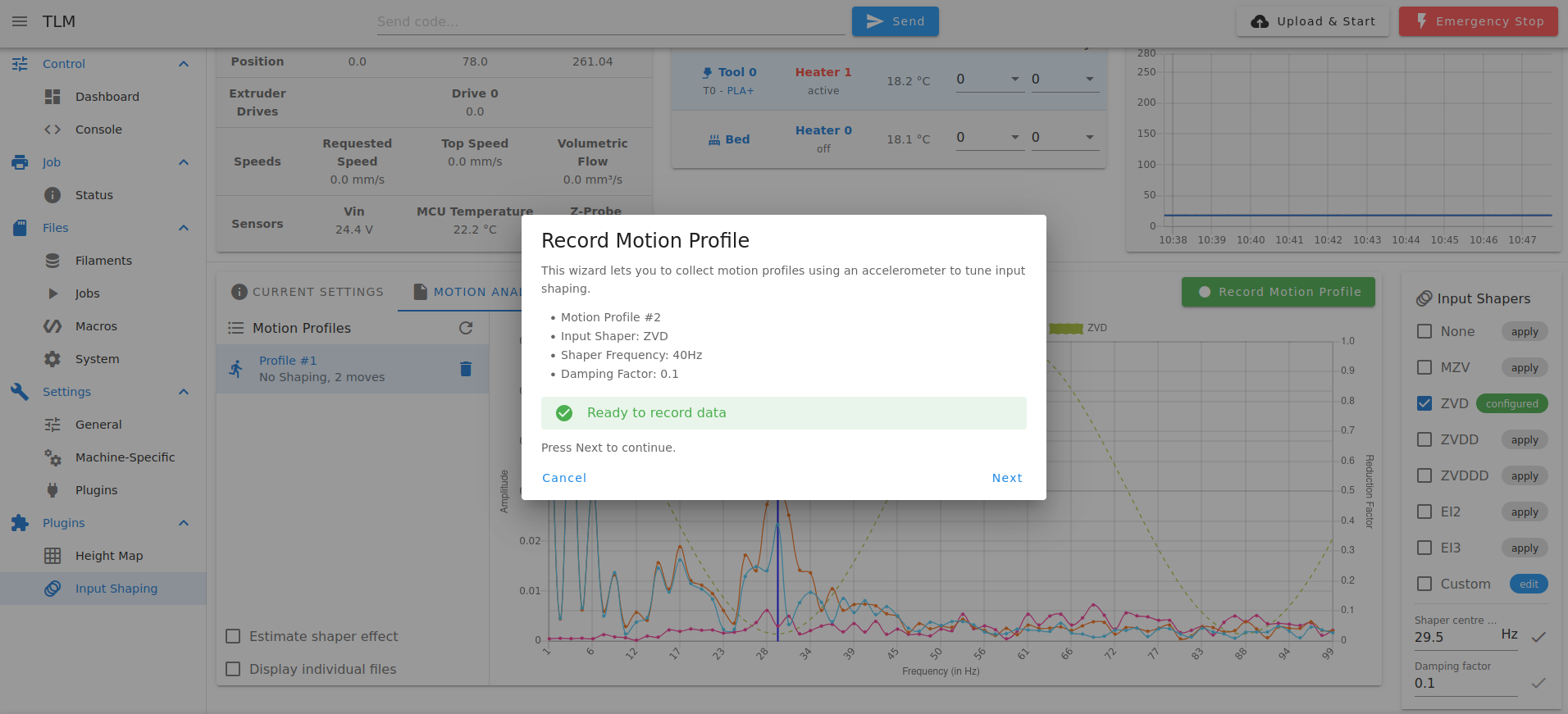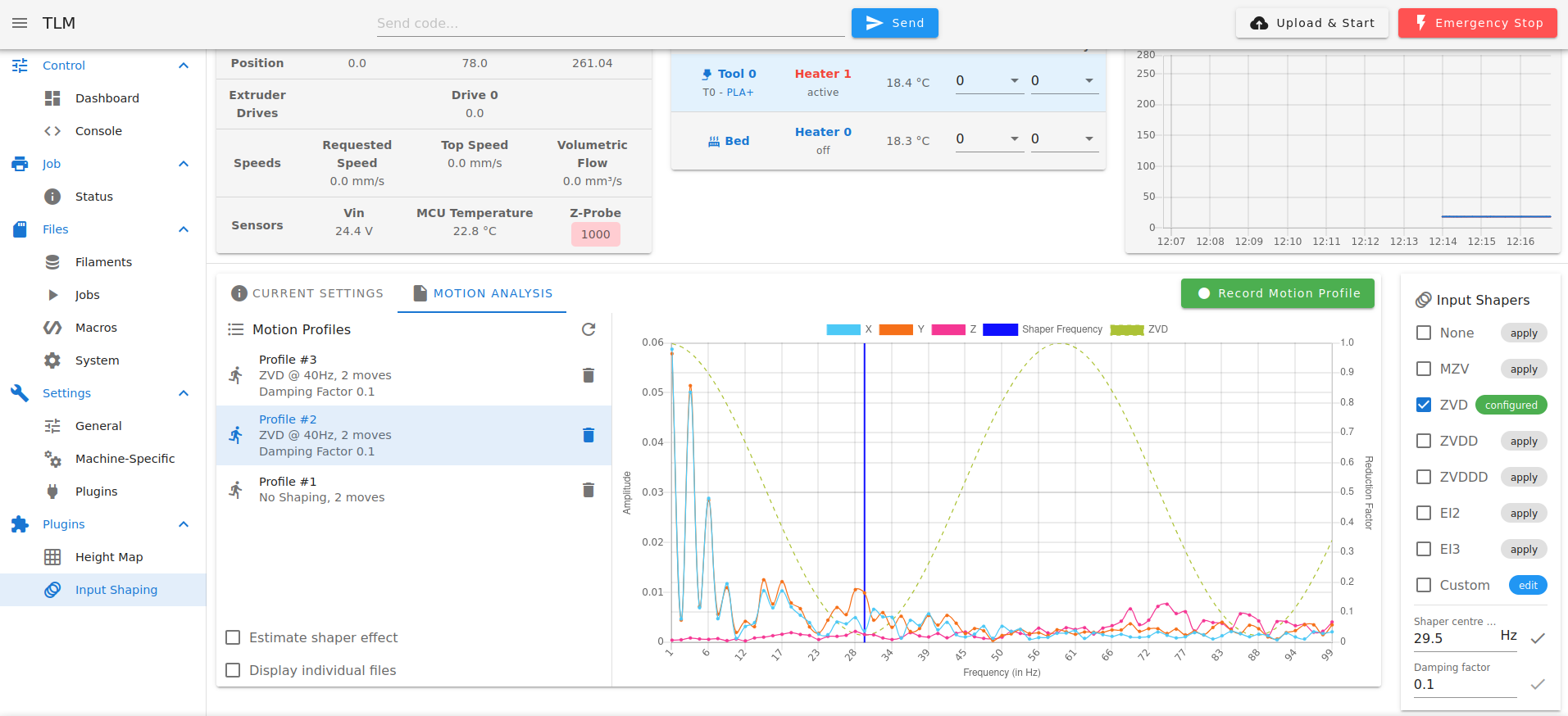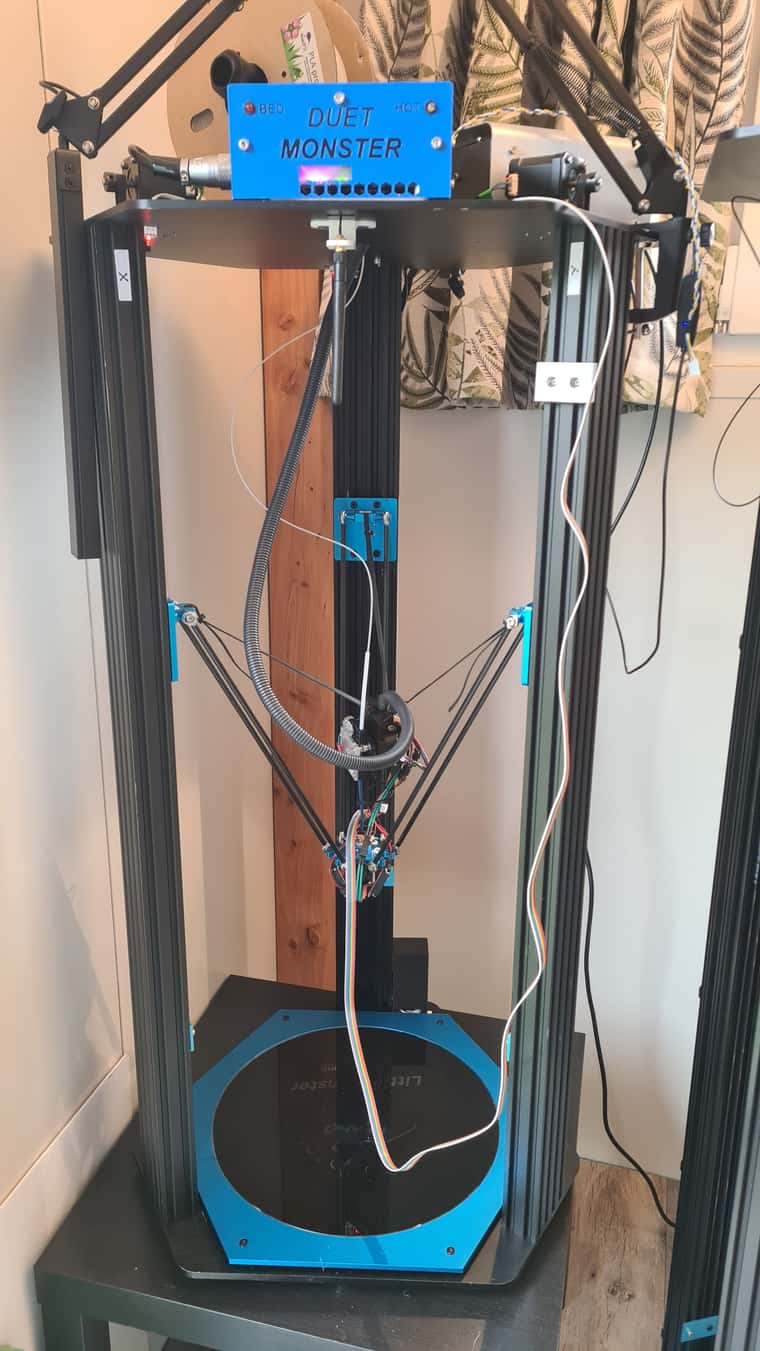Input shaping user interface bug? Or just user confusion?
-
Hi everyone,
So over the break I have a bit of time to finally wire up an accelerometer and try out input shaping on my Duet 3 Mini 5+ powered Little Monster delta printer.
Almost everything looks right, except when I record a motion profile, the window that pops up shows a different frequency that what I've selected in the lower right of the screen.

Then, once the motion profile is created, its label shows 40Hz also.

What's going on? Where does the 40Hz comes from??? That's not the filter frequency I want.
I'm running the latest firmware, 3.5.4. I had a search of the forums to find out more and it looks like the input shaping will be changing for 3.6, so not sure if this is a bug and if so may not be worth chasing.
I was also wondering about the pros and cons of a lower damping factor. I couldn't find any information on this anywhere. DWC looks to use 0.1 as a default, but a lower value like 0.01 seems to lower resonances even further. No doubt there is some trade off by using a very low value though?
Here's the printer with accelerometer and cable in place, just for interest:

-
@martinv Did you click the tick box next to the 29.5 Hz after you entered it?
-
@T3P3Tony No I did not. LOL. That's the problem by the looks of it. Just checking now I see that the tick turns slightly darker and most importantly, becomes clickable once the frequency field has been changed. I missed that.
Thank you!
-
Those Delta printers always amaze me... so crazy complex looking, to say the least.
I'm getting ready to wire in my ADXL345 to my Duet 3 Mini5+ as well and wondered how that flat ribbon cable is working out for you? Everything I have read suggests using STP Ethernet CAT 6 or above to help prevent interference and subsequent data loss.
I'm trying to keep the overall mass down on the gantry on my Core XY RatRig as the wiring loom there is already full of wires and the more mass you add to that toolhead, the more you have to compensate for.
Have you had any interference issues or data drop? I'm going to cut and weigh the corresponding lengths or ribbon cable vs Ethernet and see which one is lighter & more flexible.
Also- My ADXL has the pinouts already labeled, but I cannot find the Duet side pinouts- I believe it is like 6 wires or such.
I finally found the pin outs on the docs site. I was searching for ADXL which returned zero results. Doh.
https://docs.duet3d.com/en/User_manual/Connecting_hardware/Sensors_AccelerometerCongrats on your Delta printer- very impressive machine you have there!

-
@Electriceye How it's possible to get the effector to move in a plane when it's controlled by 3 independent arms amazes me every time.
I hear what you're saying regarding the accelerometer. I think the weight of the wire running to the accelerometer is negligible compared to the weight of the print head, but I agree that less is better.
I did not have high expectations for the long ribbon cable (which had to be that long because the printer is, well, big). I wired to the temperature daughter board. It's an easy IDC connection at the Duet end, and I break out the Dupont connectors at the accelerometer end. There is a GND on pin 2 that separates the CS from the other signals. I think that might help. I didn't experience any issues or problems (for once!). The data looks reasonable, though it's transferred digitally so I'm sure problems would show up quite readily, though how it manifests I'm not sure.
I lied above. There were two issues. First one, I carefully checked all wires to make sure, absolutely, that I had the right signals from the accelerometer going to the right pin on the 10-way IDC. Then I went and plugged the 10-way connector into the wrong header. $#%!@#^& Fortunately the pin out on the other 10-way header meant I didn't kill anything.
The other thing that happened was that at one point I homed, then went to Z=0 on the big delta, and while the (5' cable from Digikey) was long enough for the initial testing, if the cable wraps itself around the effector, as wires like to do, it wasn't quite long enough and my 3D printed mount for the accelerometer went to 3D print heaven. $%#%&# again.
-
@Electriceye said in Input shaping user interface bug? Or just user confusion?:
ADXL345 to my Duet 3 Mini5+
is not supported by RepRapFirmware. the supported accelrometers ar eon the page you linked.
-
@Electriceye I had success with this LIS3DSH module:
AliExpress Feiyang store: https://www.aliexpress.com/item/1005006579261261.html
-
Correct. After I finally found that page, I realized that the ADXL345 is a no-go, which is a major bummer.
I did order the HiLetgo cheapo one off of Amazon and I hope it at least works, not expecting a lot out of it...
https://www.amazon.com/gp/product/B082W63MWL?ie=UTF8&psc=1I have some ADXL345 boards on hand leftover from another robotics project and was really hoping to use those as they worked really well before.
Michael from Teaching Tech did a video on this with great success awhile back:
https://www.youtube.com/watch?v=er7q-CJL1lc
Most likely why I was going in that direction....So why doesn't the Duet support that nomenclature? I know Klipper with Marlin can, and I see that Duet used to have a page on it, but is now old hat I suppose.
https://duet3d.dozuki.com/Wiki/AccelerometersThanks again for the feedback gentlemen!
- Cheers!
-
@Electriceye This is the old Dozuki accelerometers page: https://web.archive.org/web/20221208200435/https://duet3d.dozuki.com/Wiki/Accelerometers
This is the current version of that page: https://docs.duet3d.com/en/User_manual/Connecting_hardware/Sensors_AccelerometerThe accelerometers supported by RRF are the LIS2DW12, LIS3DH and LIS3DSH. They have a fast readout mode, which allows us to read the acceleration data without getting the artefacts in it that we saw with the ADXL345 in testing (Klipper also suffers from this). Price-wise the ADXL345 is more expensive. The LIS2DW and LIS3DH accelerometers are also supported in Klipper.
Ian
-
That's really good to know, as I def want to implement input shaping and it sounds like the LIS2DW and LIS3DH accelerometers are the way to go. What shocks me is how incredibly inexpensive those are compared to the ADXL345, with
higher resolution, less artifacts and lower cost seems counter intuitive.
I'm looking forward to getting this implemented asap, as input shaping seems to be the way to go!
Many thanks to all for the input- much appreciated!
- Cheers!